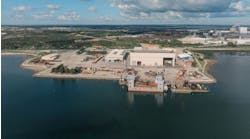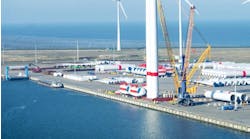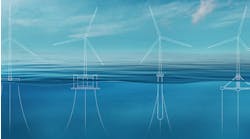The Interior and Commerce departments have approved the construction and operation of the first commercial scale offshore wind project in the United States.
The 800-MW Vineyard Wind 1 project will be located 15 mi (24 km) off the coast of Martha’s Vineyard.
Vineyard Wind, a joint venture between Avangrid Renewables and Copenhagen Infrastructure Partners, is expected to reach financial close in the second half of 2021.
The project will include 62 GE Haliade-X 13-MW wind turbines. First power is expected in 2023.
According to Vineyard Wind, it will generate electricity to power more than 400,000 homes and businesses in the Commonwealth of Massachusetts and reduce carbon emissions by more than 1.6 million tons per year.
The construction and operations plan was reviewed by more than two dozen federal, state, and local agencies over the course of more than three and a half years, the company said.
HIP plans wind power exports to UK from pods offshore Iceland
Hecate Independent Power (HIP) has initiated its HIP Atlantic wind power project.
This involves installing 10,000 MW of fixed and floating wind turbines in the North Atlantic connected to the UK by long-length, high-capacity, high-voltage direct current (HVDC) submarine power transmission cables.
A specially designed, $277-million complex at a port in northeast England will manufacture the cables.
HIP estimates the total project cost at $30 billion. It has submitted four connection applications with National Grid Co. for an initial 4,000 MW of grid connections to the UK’s 400-kV electricity transmission system across four connection sites.
Each wind farm – or pod – will be at a different location in the North Atlantic, and each will comprise 1,000 MW of wind turbines with a dedicated cable linked to the UK.
All the wind pods will be under the exclusive control of the UK electricity system operator making this Britain’s first ‘captive’ wind farm in overseas territorial waters.
HIP Atlantic is aiming to have the initial 2,000 MW of generation capacity, from pods off the southern and eastern coasts of Iceland, commissioned in early 2025.
But the HIP Atlantic HVDC transmission cables will not connect to the Icelandic transmission system.
In addition, the planned pods in the North Atlantic will all be in a different meteorological area from current North Sea and Irish Sea wind farms, allowing the UK grid system to receive renewable electricity at times when existing UK wind farms are becalmed.
HIP also claims the project could create more long-term jobs across the UK than previous wind farms connected to the National Grid, with the initial 2,000 MW capacity alone resulting in around 15,000 new positions.
Up to 500 new jobs are expected to be created in southern and eastern Iceland for the 2,000 MW pilot phase.
Trio form Atika offshore wind partnership
Ørsted, Japan Wind Development Co. (JWD), and Eurus Energy have partnered to jointly develop offshore wind projects in the Akita Prefecture.
The three companies have been developing two designated offshore wind sites under Japan’s Offshore Renewable Energy Act of 2018, both of which are located off the coast of Akita: Noshiro/Mitane/Oga and Yurihonjo. Both projects are currently progressing with the necessary permitting, Ørsted said.
The consortium is prepared to participate in Japan’s upcoming offshore wind auction round which closes on May 27, 2021.
Since 2017, JWD has conducted site investigations including wind measurements, seabed surveys, and environmental impact assessments at Noshiro and Yurihonjo. The turbines for both wind farms will be installed on bottom-fixed foundations.




